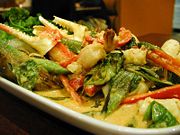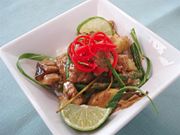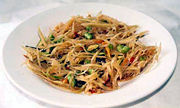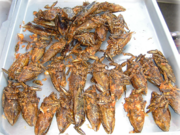Thai cuisine


Thai cuisine refers to typical foods, beverages, and cooking styles common to the country of Thailand. Thai Cuisine is known for being hot and spicy and its balance of five fundamental flavors in each dish or the overall meal - hot (spicy), sour, sweet, salty and bitter (optional).
Although popularly considered as a single cuisine, Thai food would be more accurately described as four regional cuisines corresponding to the four main regions of the country: Northern, Northeastern (or Isan), Central and Southern, each cuisine sharing similar foods or derived from those of neighboring countries. Southern curries, for example, tend to contain coconut milk and fresh turmeric, while northeastern dishes often include lime juice.
Thai food is known for its enthusiastic use of fresh (rather than dried) herbs and spices as well as fish sauce. Thai food is popular in many Western countries especially in Australia, New Zealand, some countries in Europe such as the United Kingdom, as well as the United States, and Canada.
Contents |
Serving
Instead of a multiple main course with side dishes found in Western cuisine, a Thai full meal typically consists of either a single dish or rice khao (Thai: ข้าว) with many complementary dishes served concurrently.
Rice is a staple component of Thai cuisine, as it is of most Asian cuisines. The highly prized, sweet-smelling jasmine rice (khao hohm mali) is indigenous to Thailand. This naturally aromatic long-grained rice grows in abundance in the verdant patchwork of paddy fields that blanket Thailand's central plains. Steamed rice is accompanied by highly aromatic curries, stir-frys and other dishes, incorporating sometimes large quantities of chillies, lime juice and lemon grass. Curries, stir-frys and others may be poured onto the rice creating a single dish called khao rad gang (Thai: ข้าวราดแกง), a popular meal when time is limited. Sticky rice (khao neow, Thai: ข้าวเหนียว) is a unique variety of rice that contains an unusual balance of the starches present in all rice, causing it to cook up to a sticky texture. It is the daily bread of Laos and substitutes ordinary rice in rural Northern and Northeastern Thai cuisine, where Lao cultural influence is strong.
Noodles, known in much of Southeast Asia by the Chinese name kwaytiow (Thai: ก๋วยเตี๋ยว), are popular as well but usually come as a single dish, like the stir-fried Pad Thai (Thai: ผัดไทย) or noodle soups. Many Chinese cuisine are adapted to suit Thai taste, such as khuaytiow rua (Thai: ก๋วยเตี๋ยวเรือ), a sour and spicy rice noodle soup.
There is a uniquely Thai dish called nam prik (Thai: น้ำพริก) which refers to a chilli sauce or paste. Each region has its own special versions. It is prepared by crushing together chillies with various ingredients such as garlic and shrimp paste using a mortar and pestle. It is then often served with vegetables such as cucumbers, cabbage and yard-long beans, either raw or blanched. The vegetables are dipped into the sauce and eaten with rice. Nam prik may also be simply eaten alone with rice or, in a bit of Thai and Western fusion, spread on toast.
Thai food is generally eaten with a fork and a spoon. Chopsticks are used rarely, primarily for the consumption of noodle soups. The fork, held in the left hand, is used to push food into the spoon. However, it is common practice for Thais and hill tribe peoples in the North and Northeast to eat sticky rice with their right hands by making it into balls that are dipped into side dishes and eaten. Thai-Muslims also frequently eat meals with only their right hands.
Often Thai food is served with a variety of spicy condiments to embolden dishes. This can range from dried chili pieces, or sliced chili peppers in rice vinegar, to a spicy chili sauce such as the nam prik mentioned above.
Ingredients
The ingredient found in almost all Thai dishes and every region of the country is nam pla (Thai น้ำปลา), a very aromatic and strong tasting fish sauce. Shrimp paste, a combination of ground shrimp and salt, is also extensively used.
Thai dishes in the Central and Southern regions use a wide variety of leaves rarely found in the West, such as kaffir lime leaves (bai makrut, Thai ใบมะกรูด). The characteristic flavour of kaffir lime leaves appear in nearly every Thai soup (e.g., the hot and sour Tom yam) or curry from those areas. It is frequently combined with garlic, galangal, lemon grass, turmeric and/or fingerroot (krachai), blended together with liberal amounts of various chillies to make curry paste. Fresh Thai basil is also used to add fragrance in certain dishes such as Green curry. Other typical ingredients include the small green Thai eggplants, tamarind, palm and coconut sugars, lime juice, and coconut milk. A variety of chilies and spicy elements are found in most Thai dishes.
Other ingredients also include pahk chee (cilantro or coriander), rahk pahk chee (cilantro/coriander roots), curry pastes, pong kah-ree (curry powder), si-yu dahm (dark soy sauce), gung haeng (dried shrimp), pong pa-loh (five-spice powder), tua fahk yao (long beans or yard-long beans), nahmahn hoi (oyster sauce), prik Thai (Thai pepper), rice and tapioca flour, and nahm prik pao (roasted chilli paste).
Although broccoli is often used in Asian restaurants in the west in pad thai and rad na, it was never actually used in any traditional Thai food in Thailand and is still rarely seen in Thailand. Usually, gailan is used.
Famous dishes
Many Thai dishes are familiar in the West. In many dishes below, different kinds of protein can be chosen as the ingredient, such as beef, chicken, pork, duck, tofu or seafood.
Breakfast dishes
- Jok (Thai: โจ๊ก) - a rice porridge very commonly eaten in Thailand for breakfast. Similar to the rice congee eaten in other parts of Asia.
- Khao Tom (Thai: ข้าวต้ม) - a Thai style rice soup, usually with pork, chicken or shrimp.
Individual dishes

- Khao Pad (Thai: ข้าวผัด) - One of the most common dishes in Thailand, fried rice, Thai style. Usually with chicken, beef, shrimp, pork, crab or coconut or pineapple, or vegetarian ( jay (Thai: เจ).
- Pad Thai (Thai: ผัดไทย) - rice noodles pan fried with fish sauce, sugar, lime juice or tamarind pulp, chopped peanuts, and egg combined with chicken, seafood, or tofu.
- Rad na (Thai: ราดหน้า) - wide rice noodles in gravy, with beef, pork, chicken, shrimp, or seafood.
- Khao pad naem (Thai: ข้าวผัดแหนม) - fried rice with fermented sausage (typically from the Northeast)
- Pad see ew (Thai: ผัดซีอิ๊ว) - noodles stir-fried with see ew dum (thick soy sauce) and nahm plah (fish sauce) and pork or chicken.
- Pad kee mao (Thai: ผัดขี้เมา) - noodles stir-fried with Thai basil
- Khao khluk kapi (Thai: ข้าวคลุกกะปิ) - rice stir-fried with shrimp paste, served with sweetened pork and vegetables.
- Khanom chin namya (Thai: ขนมจีนน้ำยา) - round boiled rice noodles topped with various curry sauces and eaten with fresh leaves and vegetables.
- Khao soi (Thai: ข้าวซอย) - crispy wheat noodles in sweet chicken curry soup (a Northern dish)
- Khao pad gai (Thai: ข้าวผัดไก่) - fried rice with chicken
- Gai pad grapao (Thai: ไก่ผัดกะเพรา) - minced chicken with garlic, chilies, and Holy basil
- Gai pad med mamoung himaphan (Thai: ไก่ผัดเม็ดมะม่วงหิมพานต์) - juicy chunks of chicken with cashew nuts and chilies

- Tom yam (Thai: ต้มยำ) - hot & sour soup with meat. With shrimp it is called Tom yam goong or Tom yam kung (Thai: ต้มยำกุ้ง), with seafood (typically shrimp, squid, fish) Tom yam talae (Thai: ต้มยำทะเล), with chicken Tom yam gai (Thai: ต้มยำไก่).
- Gai Pad Khing (Thai: ไก่ผัดขิง) - chicken stir-fried with sliced ginger.
- Tom kha gai (Thai: ต้มข่าไก่) - hot sweet soup with chicken and coconut milk.
- Saté (Thai: สะเต๊ะ) - grilled meat, usually pork or chicken, served with cucumber salad and peanut sauce (actually of Indonesian origin, but now a popular street food in Thailand).
- Red curry (Gaeng Phet lit. 'hot curry', Thai: แกงเผ็ด) - made with copious amounts of dried red chillies
- Green curry (Gaeng khiew-waan, Thai: แกงเขียวหวาน) - green curry, made with fresh green chillies and flavoured with Thai basil, and chicken or fish meatballs. This dish is one of the spiciest of Thai curries.
- Massaman curry (Thai: แกงมัสมั่น) - an Indian style curry, usually made by Thai-Muslims, containing roasted dried spices, such as coriander seed, that are rarely found in other Thai curries.
- Pad prik (Thai: ผัดพริก) - usually beef stir fried with chili, called Neua pad prik (Thai: เนื้อผัดพริก)
- Pad kaphrao (Thai: ผัดกะเพรา) - beef, pork or chicken stir fried with Thai holy basil.
- Pad pak ruam (Thai: ผัดผักรวม) - stir fried combination of vegetables depending on availability and preference.
- Panaeng (Thai: พะแนง) - dry curry with beef (Panang beef, Thai: พะแนงเนื้อ), chicken, or pork. It includes some roasted dried spices similar to Massaman curry.
- Tod man (Thai: ทอดมัน) - deep fried fishcake made from knifefish (Tod man pla krai, Thai: ทอดมันปลากราย) or shrimp (Tod man kung, Thai: ทอดมันกุ้ง)
- Boo Jah (Thai: ปูจ๋า) - crab cakes with pork, garlic, and pepper served with a simple spicy sauce, such as Sri Rachaa sauce, sweet-hot garlic sauce, nahm prik pao (roasted chili paste), or red curry paste and chopped green onions.
- Choo-Chee Plah Ga-Pong (Thai: ฉู่ฉี่ปลากระพง) - snapper in choo-chee curry sauce (thick red curry sauce)
The cuisine of Northeastern Thailand is shared with the cuisine of Laos, as Isan people are of Lao heritage and speak a language that is mutually intelligible with the Lao language.

- Som tam (Thai: ส้มตำ, IPA: som ɗam), known in Lao/Isan language as ตำมักหุ่ง (IPA: ɗam mak huŋ). grated papaya salad, pounded with a mortar and pestle. There are three main variations: Som tam poo (Thai: ส้มตำปู) with salted black crab, and Som tam Thai (Thai: ส้มตำไทย) with peanuts, dried shrimp and palm sugar and Som tam plara (Thai: ส้มตำปลาร้า) from north eastern part of Thailand (Isan), with salted gourami fish, white eggplants, fish sauce and long bean.
- Larb (Thai: ลาบ) - sour salads containing meat, onions, chillies, roasted rice powder and garnished with mint.
- Nam Tok (Thai: น้ำตก) - made with beef and identical to larb, except that the beef is cut into thin strips rather than minced.
- Yam (Thai: ยำ) - general name for any type of sour salad, such as those made with glass noodles (Yam Wun Sen, Thai: ยำวุ้นเส้น), or with seafood (Yam Talae, Thai: ยำทะเล).
- Tom saep (Thai: ต้มแซบ) - Northeastern-style hot & sour soup
- Gai yang (Thai: ไก่ย่าง) - marinated, grilled chicken
- Sticky rice (Thai: ข้าวเหนียว)
- Nam prik num (Thai: น้ำพริกหนุ่ม) - dipping sauce made from roasted eggplant, green chillies, and garlic grounded together in a mortar and pestle.
Desserts and drinks
- Kao niao ma muang (Thai: ข้าวเหนียวมะม่วง) - Sticky rice and ripe mango
- Kao niao Durian (Thai: ข้าวเหนียวทุเรียน) - Sticky rice and durian in coconut milk
- Gluay buad chee (Thai: กล้วยบวชชี)- Banana in coconut milk
- Foi Tong (Thai: ฝอยทอง), Tong yib (Thai: ทองหยิบ), Tong yod (Thai: ทองหยอด) - Different forms of egg yolk mixed with sugar and other ingredients. Some believe this is European in origin, particularly through the influence of Maria Guyomar de Pinha in the 17th century.[1]
- Kanome Maw Gaeng (Thai: ขนมหม้อแกง) - sweet potato pudding
- Fried Banana with Ice Cream
- Cha Yen (Thai: ชาเย็น) - Thai Iced Tea
- Kah-Feh Yen (Thai: กาแฟเย็น) - Thai Iced Coffee
Coconut is a main ingredient in desserts, in particular the milk, and the shredded coconut pieces. The coconut milk is used in a lot of dishes as the soup or base and some of the desserts are rolled in shredded coconut for taste and look. These are some of the desserts that contain coconut:
- Lod Chong Nam Ka Ti (Thai: ลอดช่องน้ำกะทิ) – Pandan flavored rice flour noodles in coconut milk
- Kanom Tan (Thai: ขนมตาล) – Palm flavored mini cake with shredded coconut on top
- Ruam Mit (Thai: ร่วมมิตร) – Chestnuts covered in flour, jackfruit, tapioca, and Lod Chong in coconut milk
- Kanom Chun (Thai: ขนมชั้น) – multi-layers of pandan-flavored sticky rice flour mixed with coconut milk
- Kanom Bua Loy (Thai: ขนมบัวลอย) – taro root mixed with flour into balls in coconut milk
| Life in Thailand |
|---|
| Cuisine |
| Culture |
| Dance |
| Puppet |
| Instruments |
| Demographics |
| Economy |
| Education |
| Film |
| Holidays |
| Languages |
| Literature |
| Media |
| Monarchy |
| Music |
| Politics |
| Religion |
| Society |
| Sport |
| Tourism |
| edit box |
Variations

Throughout the country there are many interpretations and variations on these common dishes. Other dishes from the northern part of Thailand include unique sauces and exotic foods, such as raw beef, fermented fish paste, and deep fried insect larvae (also enjoyed in the Northeast). The culinary creativity even extends to naming: one tasty larva translates as "freight train" (rot duan ; Thai: รถด่วน) and the smallest, hottest chillies are known as phrik khii nuu (Thai: พริกขี้หนู), literally "mouse dropping chillies". They are called that because of their size. In the Northeast, eating insects is common, and the giant water bug (mang dah; Thai: แมงดา) is popular.[2]
The dish nam prik pla too (Thai: น้ำพริกปลาทู) is particularly common in central Thailand because of its low cost. It consists of deep fried Indian mackerel, Rastrelliger kanagurta (pla too) served with a shrimp-and-chilli paste (nam prik kapi). The fish are traditionally presented in pairs, placed head-to-tail on a round bamboo dish.
References
- ↑ Thailand: World Food - Page 87 by Joe Cummings [1]
- ↑ http://www.thaibugs.com/edible%20insects.htm - ThaiBugs.com
Further reading
- Joe Cummings, Lonely Planet World Food Thailand, 288 pages, Lonely Planet Publications, 2000, ISBN 978-1864500264
External links
- Cuisine of Thailand at the Open Directory Project
|
|||||||||||||||||
|
|||||
|
|||||||||||
|
|||||||||||||||||